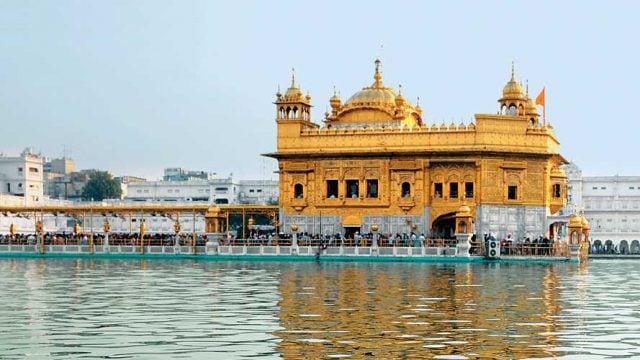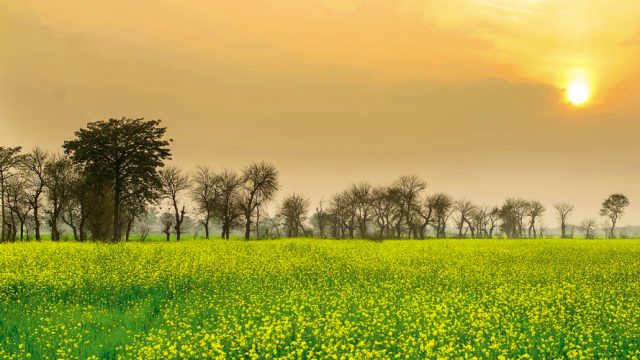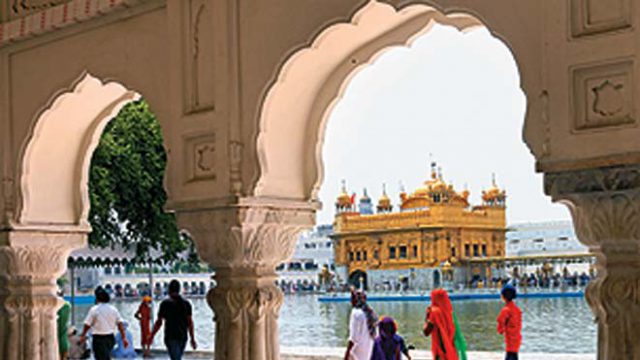After four days and nearly 750 kilometres of driving through the rains lashing Punjab, we finally found what we had come for. Our first glimpse of it: soaring tubes and concave roofs clad in reflective stainless steel, emerging from a dusty landscape sprinkled liberally with indigo and saffron pennants fluttering in the shadow of several historic, domed gurdwaras. We had finally arrived at the spiritual heartland of the Sikhs, Anandpur Sahib, and the extraordinary Virasat-e-Khalsa. But I get ahead of myself. Our Punjab odyssey was bookended by visits to Amritsar and Chandigarh, and the journey began when we set off from Delhi for Amritsar. If the superstition that rain on one’s departure augurs a good journey has any bearing in truth, then we were in for a fantastic road trip. As we pulled into Amritsar after a non-stop, 10-hour, nearly-500-km drive on the Grand Trunk Road from Delhi, we couldn’t see the tarmac for the sheets of rain blanketing the windscreen.
At first glance, Amritsar under water was relatively disappointing, with all the unflattering characteristics of any rapidly growing middle-tier city in India: rutted roads and chaotic traffic, undistinguished, grungy buildings and shops. But, as we set out to explore, we found that it had much to offer: the serene Golden Temple set in the holy tank that gives the city its name; the Durga temple built to imitate it; the Maharaja Ranjit Singh Museum; Jallianwala Bagh; and the vibrant and lively bylanes of the Old Town itself, with its havelis adorned with wooden latticework grills, doorways and balconies.
A nice way to really experience Amritsar, we found, was to take one of Punjab Tourism’s guided walks. While one of these is a morning walk taking in the Panj Sarovar (the five sacred tanks of the Sikhs), the other is a leisurely stroll through the twisting warren of gallis past both religious and secular sights. Our meander through the Old Town was conducted through calf-deep water, thanks to the incessant rain. Uncomfortable, no doubt, but it gave the walk a character all its own once we had got used to it. Umbrellas unfurled, our children rode on a rickshaw hired for the occasion while we, in our slippers, waded behind our indefatigable guide, Mr Chawla, a sprightly Sikh gentlemen who stoically ignored his soaking wet corduroy trousers and squelchy leather shoes.

We took in sights like the mint established by Maharaja Ranjit Singh (which the Akal Takht apparently closed down when it started printing peacocks on all coinage because the king’s mistress was a dancing girl called Morni!); Crawling Street (where the British forced locals to crawl the length of the street as punishment for an assault on a British woman living in the city in the early 20th century); living temples inside people’s homes; Jalebiwala Chowk, the site of a demonstration of religious unity in the face of British tyranny, still selling its namesake sweetmeat; and tiny alleyways winding through the residential neighbourhoods (katras) carved out by various Sikh jathas, or martial clans. We were living history at every street corner, every halt.

From the temporal to the spiritual: we wended our way from the bustling commerce of the Old Town to the hushed serenity of the Golden Temple. The atmosphere of the Swarn Mandir was magical. As we walked on sodden jute carpets, the hypnotic chanting washed over us along with the drizzle. We took in sights like devotees queuing for kara parshad, the imposing Akal Takht at the start of the bridge leading to the brilliantly gilded shrine that gives the complex its name, the majestic temple tank stocked with plump carp, the devout bathing in this sacred pool, the well-tended gardens, and inscribed marble pavements and walls.
A hop away from the Golden Temple is Jallianwala Bagh with its own tale of bloodshed. But an unimaginatively created memorial and the passage of time have conspired to diminish the tragedy of 1919. Other sights in the city include the sprawling Ram Bagh, which was Maharaja Ranjit Singh’s summer palace. While it lies in sad ruin, there appear to be ongoing, albeit desultory, attempts to renovate the decrepit buildings. The Maharaja Ranjit Singh Museum, also in the same complex, uses interesting dioramas to capture this great warrior king’s tumultuous life and times.
From old warriors to their modern-day equivalents: an easy 30-kilometre drive from the heart of Amritsar is India’s border with Pakistan. Past the colonial baroque building of Panjab University, the highway to the border made for pleasurable driving past fields being tilled by farmers — signs of ordinariness so close to a fractious boundary line. The closing-the-border ceremony at Atari-Wagah was quite simply a spectacle: part carnival, part nightly military exercise. This tightly scripted rite is unadulterated jingoistic fun: smartly turned out, goosestepping jawans, ear-splittingly loud patriotic music, raucous shouts of ‘Bharat Mata ki Jai!’, and much moustache-twirling, turban-tweaking and muscle-flexing machismo.
Punjab is, of course, more than just Amritsar. About 60 kilometres to the city’s northeast, as the car glides down country lanes past mustard fields, trundling tractors, roadside dhabas, turbaned men reclining on charpoys, and push cart vendors peddling their colourful wares, is the oftentimes-overlooked town of Kapurthala. This erstwhile kingdom is dotted with little gems, none more so than its mini-Versailles, the Jagatjit Palace. Modelled on the palace of Louis XIV, it was commissioned in the early part of the 20th century by the flamboyant Francophile Maharaja Jagatjit Singh, who perhaps imagined himself Punjab’s own Sun King. While the outer façade retains its appeal, the interiors appear a little more workaday with hundreds of boys — little and big — pelting their way past us to their classes; the palace was converted into a Sainik School soon after Independence.
While the palace is not all-access, we did manage a sneak peak at the Maharaja’s magnificent study with its sumptuously painted ceilings and wood-panelled walls replete with courtly portraits and historical scenes. This room now serves as a library where, instead of a royal audience, we were met with pin-drop silence and the curious stares of schoolboys. By the admission of one of the head teachers, much of the art and artefacts of the erstwhile royal family are collecting dust behind closed doors because the army has neither the funds nor the personnel to maintain and display them. A suggestion? Moving the collection of artefacts to the fantastic Government Museum in Chandigarh would perhaps allow more people to see and appreciate a fascinating segment of India’s heritage.
The other little jewel worth visiting in Kapurthala is the Moorish mosque. Built as a nod to communal harmony by Maharaja Jagatjit Singh, and inaugurated in 1930, the mosque, like the palace, has seen better days. Overseen by the ASI, it wears a forlorn look with its only inhabitants being doves and bats. The structure itself is beautiful with a large inner courtyard and cool marble-floored corridors, and a large, tree-filled charbagh-style garden out in front. If the palace transplants France to India, the mosque itself would not look out of place in Marrakech or Fez.
If Kapurthala with its larger-than-life royals and their self-indulgent lifestyles represented one side of Punjab, then Anandpur Sahib — a further 120 kilometres away on a dusty road filled with pick-up trucks transporting the faithful — with its religious overtones and its emphasis on humility and simplicity represented the other.
There, in the holy heartland of all Sikhs, we paid homage at the stunning Virasat-e-Khalsa. Built to celebrate over 500 years of Sikhism’s rich heritage, this building complex on the outskirts of Anandpur Sahib draws deeply from religious and regional architecture to create a striking, sandstone monument replete with dramatic bridges, colonnaded walkways, monu-mental arches and tranquil reflecting pools. Multiple stainless steel roofs provide a uniquely visual contrast to the more traditional religious architecture ringing it, even while somehow melding seamlessly into this milieu. The museum in the complex was thronged by the faithful who came to Anandpur Sahib to worship at Kesgarh Sahib and by the odd tourists like us. Which is a shame, because the interiors offer a compelling visual narrative of Sikh and Punjabi history using a variety of local material and canvasses — handwoven textiles (yes, of course, phulkari!), marble inlay sculptures, paper cut-outs and leather puppets — to more state-of-the-art light sculptures and computer-generated interactive films. The museum begins with a dramatic introduction: a richly observed, wonderfully detailed and intensely evocative three-storey-high curving wall painting that captures the vibrancy of everyday life in Punjab, mixed in with its famous myths (think Sohni-Mahiwal and Heer-Ranjha); appropriate music and sounds are piped in to bring alive different seasons. It is a son-et-lumière where the audience is on the move as they climb a winding ramp that gives a 360-degree view of Punjabi songs, seasons and stories.
It was fitting that we started our trip in Amritsar with its historical resonance and ended in Chandigarh, a city that underscored post-Independence India’s tryst with modernity. We chalked up another 80 kilometres on our odometer en route to this much-feted, Le Corbusier-designed state capital that’s suffused with laidback charm. The grid-like layout makes the city easy to navigate, while wide roads flanked by tree-lined avenues make driving a hassle-free, honking-free experience. Contrasting with the rigid symmetry of the city was the four-acre sprawl of Nek Chand’s Rock Garden, which had a wonderfully whimsical quality to it. Particularly entrancing are small sculptural armies constructed from a variety of discarded material ranging from broken bits of crockery to glass and pebbles, ranks of Modigliani-ish figurines created from brightly coloured broken glass bangles and long, undulating corridors filled with wooden swings, an interesting architectural take on a feature typical of Punjab.
For those inclined toward a more formal approach to artistic expression, the Government Museum and Art Gallery was a revelation. This well-maintained and thoughtfully curated museum has an impressive range of exhibits. Among its highlights was its well-documented, spectacular collection of statuary from Gandhara, including the achingly beautiful sculptures that are among the first imagined depictions of the Buddha. A section showcasing Indian miniature art, a stellar display of Indian textiles and a modern art selection covering masters like Jamini Roy, Amrita Sher-Gil and Nicholas Roerich — all combined to make this a finely faceted gem of a museum.
And so, Punjab, which was never top-of-the-mind as a holiday destination, proved a very pleasant surprise. Where else, after all, would you get to see Moroccan mosques and French palaces amidst mustard fields as you motor around? And all under cool, scudding monsoon clouds.
The information
Getting there
Driving 500km from Delhi to Amritsar took 10hrs because of bad weather and lots of stalled roadworks. Other distances— Amritsar to Kapurthala: 60km/ 1hr; Kapurthala to Anandpur Sahib: 120km/2.5hrs; Anandpur Sahib to Chandigarh: 80km/1.5hrs; and Chandigarh to Delhi: 260 km/4.5hrs.
Avoid busy highways and take smaller roads where possible— they are more scenic, better maintained and get you places faster. A mid-sized sedan proved ideal for the road conditions and our family of four.
Where to stay
In Amritsar, Mrs Bhandari’s Guesthouse (from Rs 2,500 for AC doubles without meals; 0183- 2228509, bhandari_guesthouse.tripod. com) is a rock in the travel firmament. The Nalagarh Fort Resort (from Rs 4,000; nalagarh.in) is ramshackle, but one of the better places to stay near Anandpur, and it offers great views of the town below. We stayed in a deluxe suite, which cost us Rs 4,500 per night including breakfast.
Where to eat
While on the road during the monsoons, it’s best to stick to bottled drinks and freshly cooked food. If you’re travelling with kids, stock up on sandwiches and juice packs for the road, wherever you find reliable restaurants. In Amritsar, try a local meal of kulcha-chhole topped with a generous dollop of home-churned butter at Brothers Dhaba. Other favourites include Brijwasi for chaat, Mohan Singh ka Dhaba for tikka and chaamp, and Kesar ka Dhaba for vegetarian specialties. Crystal Restaurant, a stalwart of the dining scene, does everything from Indian to Chinese to Continental, a la Punjab. While returning from Wagah, stop for a fancy Pakistani dinner at Sarhad. In Anandpur Sahib, any of the Verka milk bars along the highway will serve simple meals as well.
Chandigarh
Punjab
Leave a Reply
You must be logged in to post a comment.





